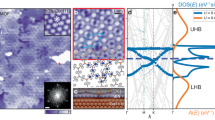Abstract
IN CONVENTIONAL superconductors, the large dependence of the superconducting transition temperature (Tc) on the isotope mass (Tc∝m−α, with α≈0.5) gives strong evidence for electron pairing by a phonon-mediated mechanism. The copper oxide superconductors, on the other hand, exhibit a small oxygen isotope effect (α≈0.02; see, for example, refs 1–14), suggesting a mechanism more complex than simple phonon-mediated pairing15. To obtain further insight into this mechanism, it is important to determine the contribution from different oxygen sites in the crystal lattice to the total oxygen isotope effect. Recently, a negative isotope effect associated with oxygen atoms in the copper oxide planes of the crystal structure was reported13 for highly doped YBa2Cu3O6 + x, implying that the apical/chain oxygens make a substantial contribution to the total oxygen isotope shift. Here we investigate this effect in optimally doped YBa2Cu3O6 + x, by measuring separately the contributions to the total isotope shift of the planar and apical/chain oxygen sites. The sum of the site-selective isotope shifts equals that of the total measured shift, illustrating the self-consistency of our results. In contrast to the previous work13, we find that more than 80% of the total (positive) isotope effect is associated with the copper oxide planes.
This is a preview of subscription content, access via your institution
Access options
Subscribe to this journal
Receive 51 print issues and online access
$199.00 per year
only $3.90 per issue
Buy this article
- Purchase on Springer Link
- Instant access to full article PDF
Prices may be subject to local taxes which are calculated during checkout
Similar content being viewed by others
References
Batlogg, B. et al. Phys. Rev. Lett. 58, 2333–2336 (1987).
Bourne, L. C. et al. Phys. Rev. Lett. 58, 2337–2339 (1987).
Bourne, L. C., Zettl, A., Barbee, T. W. & Cohen, M. L. Phys. Rev. B36, 3990–3993 (1987).
Leary, K. J. et al. Phys. Rev. Lett. 59, 1236–1239 (1987).
Morris, D. E., Kuroda, R. M., Markelz, A. G., Nickel, J. H. & Wei, J. Y. T. Phys. Rev. B37, 5936–5939 (1988).
Hoen, S. et al. Phys. Rev. B39, 2269–2278 (1989).
Crawford, M. K., Kunchur, M. N., Farneth, W. E., McCaron E. M. & Poon, S. J. Phys. Rev. B41, 282–287 (1990).
Franck, J. P., Jung, J., Mohamed, M. A-K., Gygax, S. & Sproule, G. I. Phys. Rev. B44, 5318–5321 (1991).
Bornemann, H. J. & Morris, D. E. Phys. Rev. B44, 5322–5325 (1991).
Bornemann, H. J., Morris, D. E. & Liu, H. B. Physica C182, 132–136 (1991).
Babushkina, N. et al. Physica C185–189, 901–902 (1991).
Bornemann, H, J., Morris, D. E., Liu, H. B. & Narwankar, P. K. Physica C191, 211–218 (1992).
Nickel, J. H., Morris, D. E. & Ager, J. W. Phys. Rev. Lett. 70, 81–84 (1993).
Franck, J. P., Harker, S. & Brewer, J. H. Phys. Rev. Lett. 71, 283–286 (1993).
Müller, K. A. Z. Phys. B80, 193–201 (1990).
Conder, K., Kaldis, E., Maciejewski, M., Müller, K. A. & Steigmeier, E. F. Physica C210, 282–288 (1993).
Morris, D. E. et al. Phys. Rev. B44, 9556–9560 (1991).
Conder, K. Rusiecki, S. & Kaldis, E. Mater. Res. Bull. 24, 581–587 (1989).
Conder, K., Krüger, Ch., Kaldis, E., Zech, D. & Keller, H. Physica C225, 13–20 (1994).
Zech, D., Keller, H., Müller, K. A., Conder, K. & Kaldis, E. in Proc. Int. Conf. High-Temperature Superconductivity M2HTSC IV Grenoble, France 1994; Physica C (in the press).
Plakida, N. A., Aksenov, V. L. & Drechsler, S. L. Europhys. Lett. 4, 1309–1314 (1987).
Crespi, V. H. & Cohen, M. L. Phys. Rev. B48, 398–406 (1993).
Frick, M., Morgenstern, I. & von der Linden, W. Z. Phys. B82, 339–345 (1991).
Vujic̆ić, G. M., Aksenov, V. L., Plakida, N. M. & Stamenković, S. Phys. Lett. 73A, 439–441 (1979).
Ruani, G. et al. Physica C226, 101–105 (1994).
Author information
Authors and Affiliations
Rights and permissions
About this article
Cite this article
Zech, D., Keller, H., Conder, K. et al. Site-selective oxygen isotope effect in optimally doped YBa2Cu3O6 + x. Nature 371, 681–683 (1994). https://doi.org/10.1038/371681a0
Received:
Accepted:
Issue Date:
DOI: https://doi.org/10.1038/371681a0
This article is cited by
-
The Polaronic Basis for High-Temperature Superconductivity
Journal of Superconductivity and Novel Magnetism (2017)
-
Spin Texture and Spin Dynamics in Superconducting Cuprates Near the Phase Transition Revealed by the Electron Paramagnetic Resonance
Journal of Low Temperature Physics (2016)
-
Isotope Effect at the Fano Resonance in Superconducting Gaps for Multiband Superconductors at a 2.5 Lifshitz Transition
Journal of Superconductivity and Novel Magnetism (2013)
-
Oxygen Isotope Effect in Cuprates Results from Polaron-induced Superconductivity
Journal of Superconductivity and Novel Magnetism (2011)
-
Evidence for Polaron Formation in High-Temperature Superconducting Cuprates: Experiment and Theory
Journal of Superconductivity and Novel Magnetism (2009)
Comments
By submitting a comment you agree to abide by our Terms and Community Guidelines. If you find something abusive or that does not comply with our terms or guidelines please flag it as inappropriate.



